|
"Come on you brave Yank, come
on"
Texan respect for an enemy hero at the Siege of Vicksburg in 1863
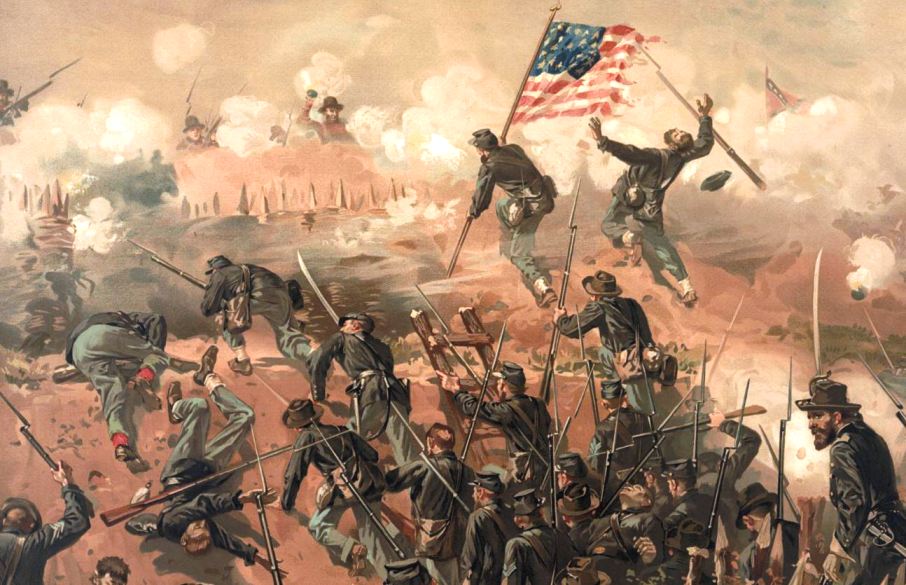
The Siege of Vicksburg, 1863 (pub. 1888)
LIKE MANY YOUNG MEN, THOMAS HIGGINS WAS DRAWN TO THE ROMANTICISM OF MARCHING
OFF TO WAR.
Born in Huntingdon, Quebec, Thomas had crossed the border from Canada in
1862 and joined the Union Army in Barry, Illinois.
He wasn't alone. Though it was illegal under the Foreign Enlistment Act of
1819 for British subjects to enlist in foreign armies, over 40,000 Canadians
did so like Thomas.
As a private in Company D of the 99th Illinois
Regiment, Thomas found himself at the walls of Vicksburg, Mississippi on May
18, 1863. Commanding the Union Army of the Tennessee was Ulysses S.
Grant.
Grant hoped for a quick victory by storming Vicksburg's defences and
overwhelming the Confederate defenders who were outnumbered three to one.
However the first assault on May 19 proved a demoralizing failure with over
a thousand casualties.
Morale improved as the Union Army was
provisioned and on the night of May 21 troops enjoyed a princely meal of
hardtack (dry ship's biscuit), beans and coffee. On the following
morning, after heavily shelling Confederate positions, Grant ordered a new
assault. While passing his troops before the attack on May 22, Grant
received a spirited chant from the Union soldiers of "Hardtack! Hardtack!"
The 99th Illinois Infantry was chosen as one of the lead units. The
regiment's color bearer had been wounded a few days before. On the morning
of the assault, regiment's acting commanding officer recounted: "Private
Thomas H. Higgins, a big, strong, athletic Irishman. solicited the privilege
of carrying the flag for the day. I gave him permission and handed over the
standard to him, telling him not to stop until he got into the Confederate
works."
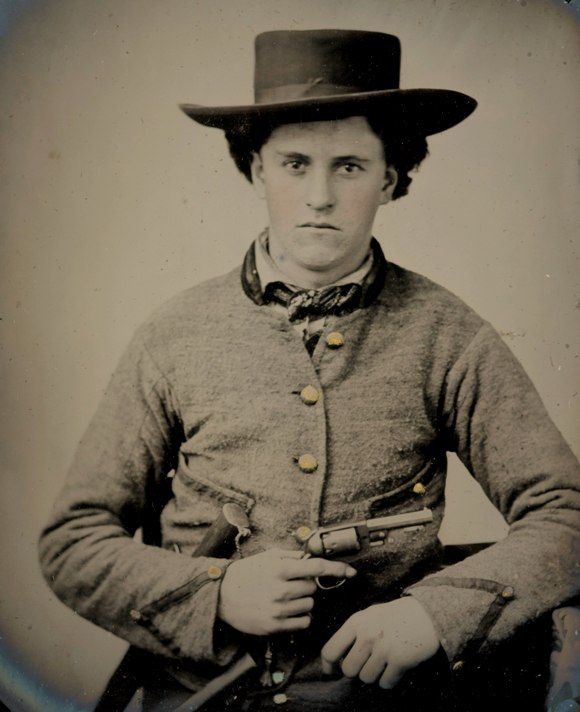
Private Charles H. Ruff
of the 2nd Texas Infantry Regiment (Library of Congress)
The target the
99th Illinois was tasked to capture was a crescent-shaped fortification
later called the 2nd Texas Lunette. Defending this key section of
defence works was the 2nd Texas Infantry. Mostly made up of men from
Houston and Galveston, the 2nd Texas were not unfamiliar with the risks of
attacking a fortified enemy position and the dangers to those who carried a
regiment's color. At the Second Battle of Corinth the previous
October, the 2nd Texas had fiercely fought to capture a battery redoubt.
At times fighting hand-to-hand, the 2nd Texas that day had five successive
color bearers fall in the action. The last to die carrying the 2nd
Texas color was their Colonel, William P. Rogers. Seeing his
regiment's falling for the fourth time, Rogers had seized them, jumped a
five-foot ditch, abandoned his dying horse and continued the assault.
He was killed soon after by canister shot.
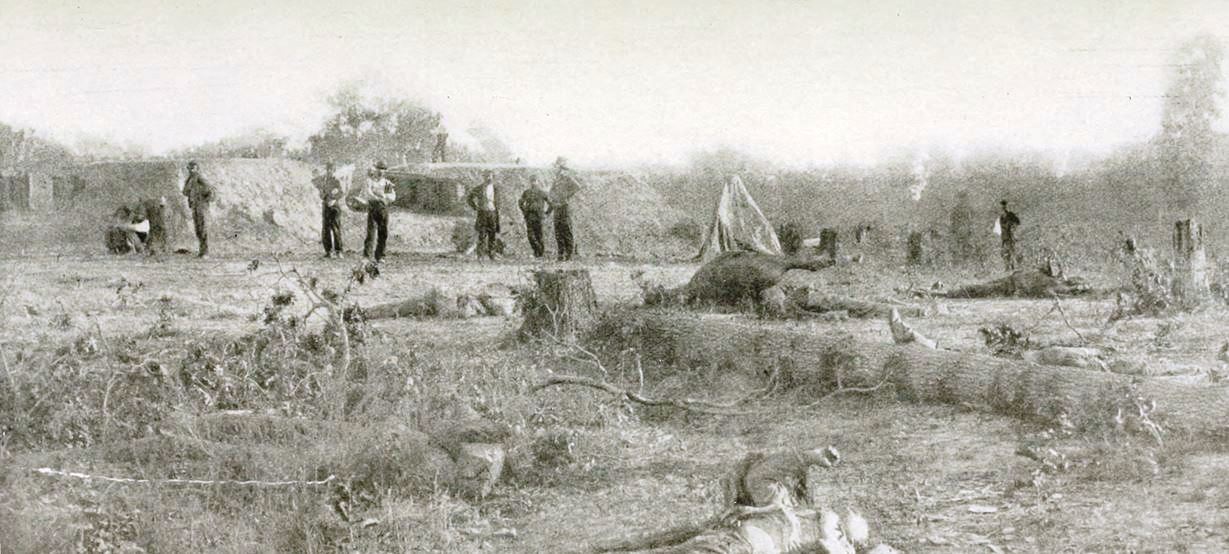 . .
Outside the Corinth Battery redoubt after the failed assault by the 2nd
Texas Infantry.
Visible are the bodies of Colonel Rogers (left background) and his horse.
That morning of May 22 at Vicksburg, the 2nd
Texas found themselves now the defenders. Retribution was at hand.
For two hours Union artillery relentlessly
pounded the earthen fortifications manned by the 2nd Texas: "the very earth
rocked and pulsated like a thing of life." When the bombardment
ceased, the 99th Illinois appeared in column with the union standard flying
in the hands of Thomas. The union assault force was "about 100 yards in
front of the breast works, and, as line after line of blue came in sight
over the hill, it presented the grandest spectacle the eye of a soldier ever
beheld", recounted Charles Evans of the 2nd Texas.
However the Texans were ready. Along with
their Springfield rifles, each man had five additional smooth-bore muskets,
loaded with buck and ball. In essence, they could deliver six times the
firepower the Union troops were expecting. The Texans held their fire
until the 99th Illinois Infantry were within fifty paces of the earthworks
then "the order to fire ran along the trenches, and was responded to as from
one gun. As fast as practiced hands could gather them up, one after another,
the muskets were brought to bear. The blue lines vanished amid fearful
slaughter." Of the three hundred of the 99th Illinois who marched
forward, a third fell killed or wounded. But Thomas was still alive
and unhurt.
Evans of 2nd Texas remembered the surprising
event that happened next:
"As the smoke was slightly lifted by the
gentle May breeze, one lone soldier advanced, bravely bearing the
flag towards the breastworks. At least a hundred men took
deliberate aim at him, and fired at point-blank range, but he never
faltered. Stumbling over the bodies of his fallen comrades, he
continued to advance. Suddenly, as if with one impulse, every
Confederate soldier with sight of the Union color bearer seemed to
be seized with the idea that the man ought not to be shot down like
a dog. A hundred men dropped their guns at the same time; each
of them seized his nearest neighbour by the arm and yelled to him:
Don't shoot at that man again. He is too brave to be killed
that way, when he instantly discovered that this neighbour was
yelling the same thing at him. As soon as they all understood
one another, a hundred old hats and caps went up into the air, their
wearers yelling at the top of their voices: 'Come on, you brave
Yank, come on.'"
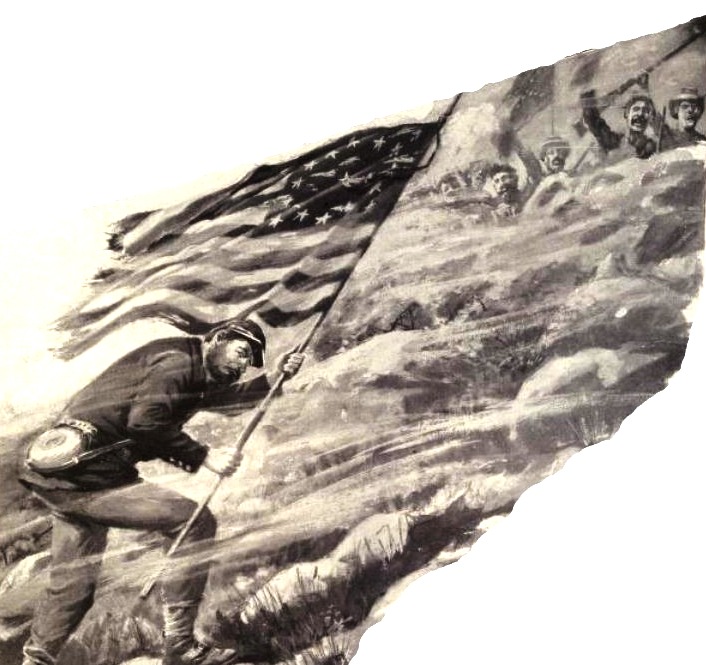
'Come on, you
brave Yank, come on.' Higgins is cheered on by the Texans. (pub. 1901)
Thomas Higgins followed his commander's orders
to the letter that day
"not to stop until he got into the Confederate works."
To the sounds of cheers of his enemy, Thomas reached the base of the
breastworks and the flag on the parapet. Surprisingly there was not a
scratch on him. After being taken prisoner, Thomas was congratulated by the
2nd Texas for his miraculous escape from death. His feat
resonated with the Texans whom themselves had lost five color bearers
at Corinth in 1862. A few days later Thomas was paroled and eventually
exchanged. He ended the war with his regiment. raising to the rank of
sergeant.
On April 1, 1898 Thomas Higgins got a surprise.
He was awarded the United States highest personal military decoration: the
Medal of Honor. But who recommended him for it? The answer was
not his comrades but his former enemies: the Texan Confederates that had
cheered him on that day.
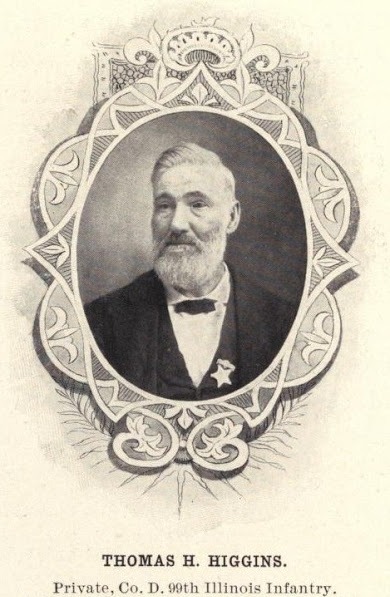
Photo of Thomas Higgins in 1998.
A Canadian in the Union Army cheered
by Texan Confederates. He was a lucky one.
Over 7,000 Canadians died in the war,
mostly on the Union side.
 |
Author Robert Henderson enjoys unearthing and
telling stories of military valour, heritage, and sacrifice
from across the globe. Lest we forget.
|
|